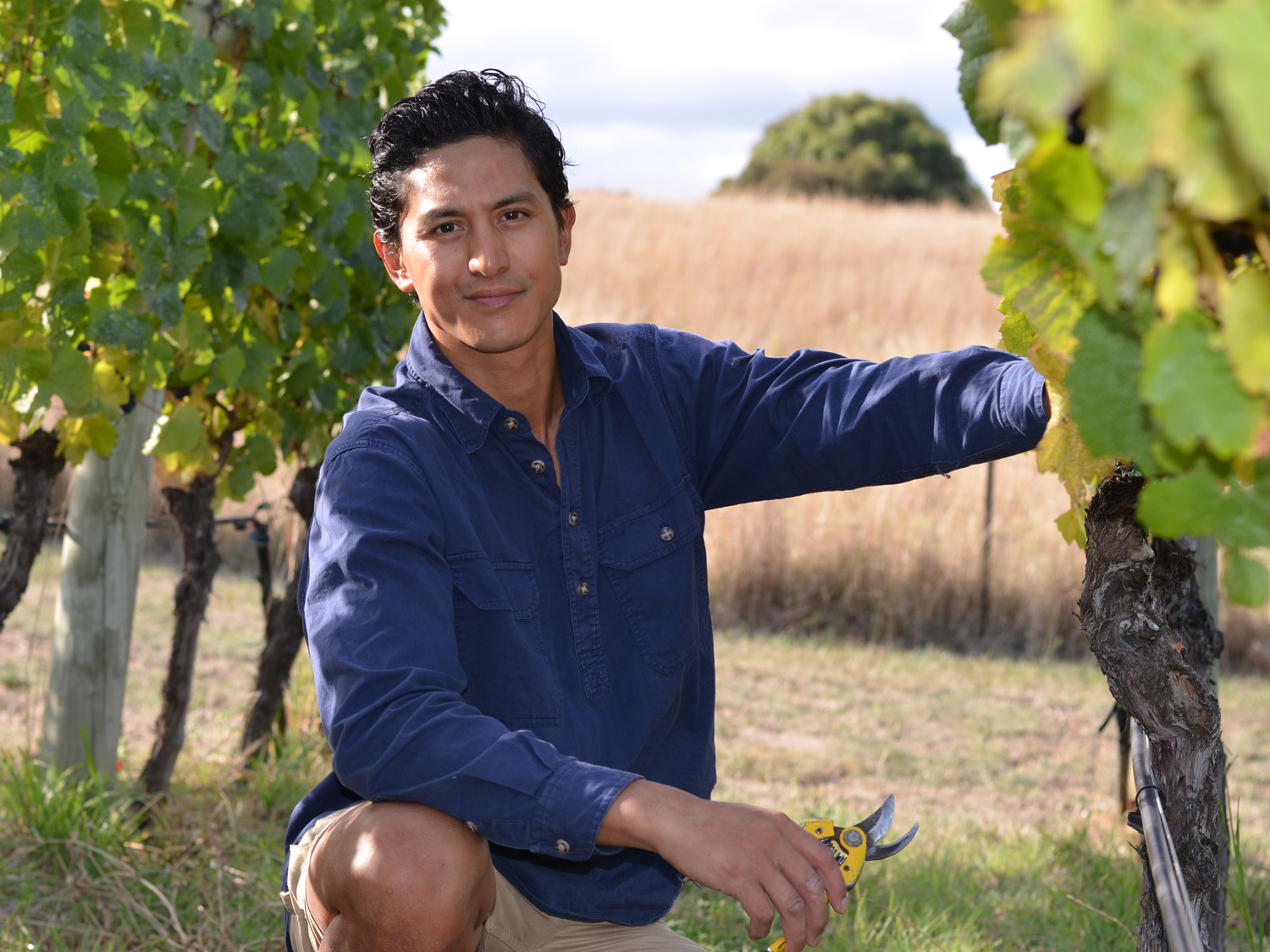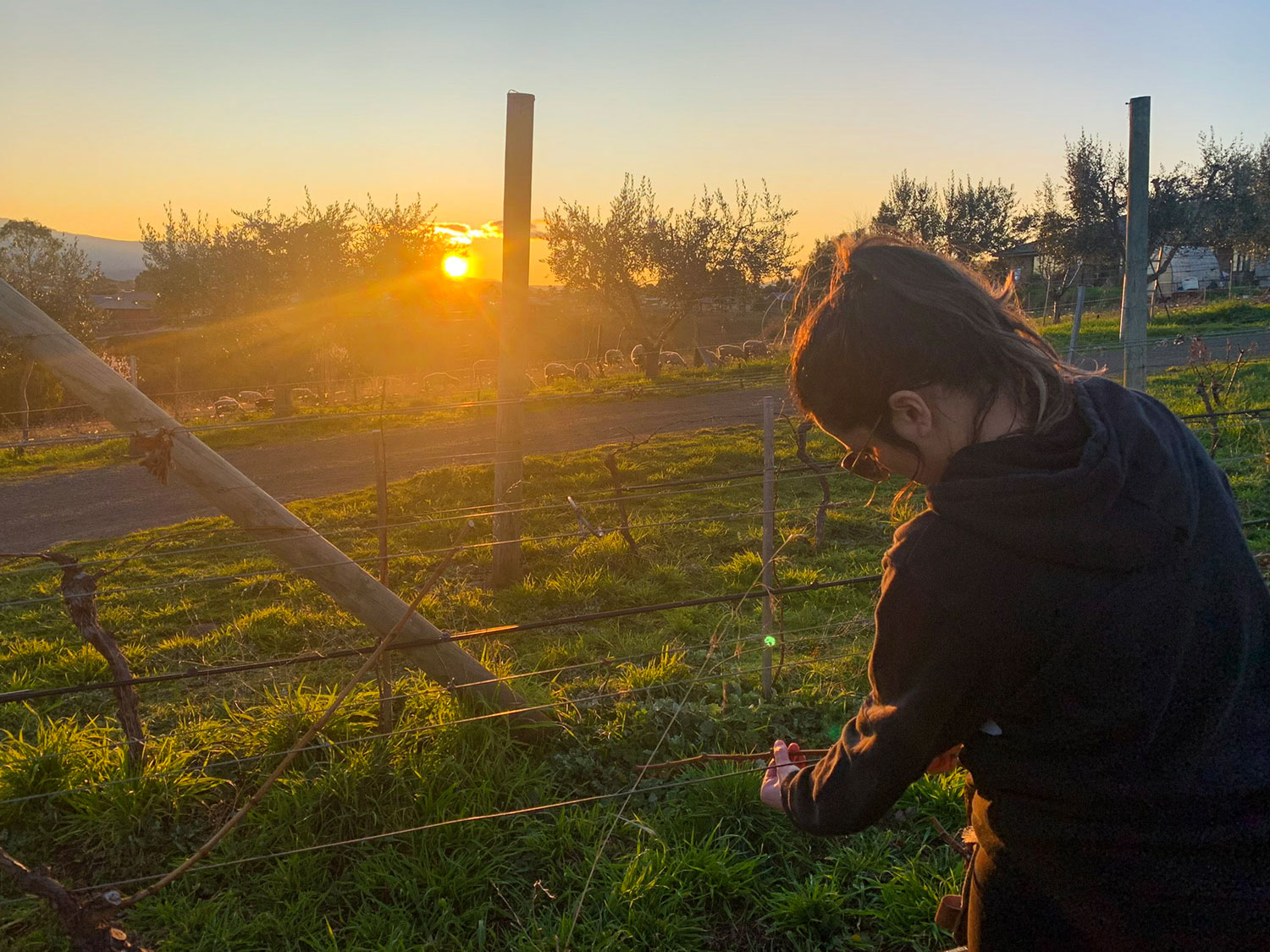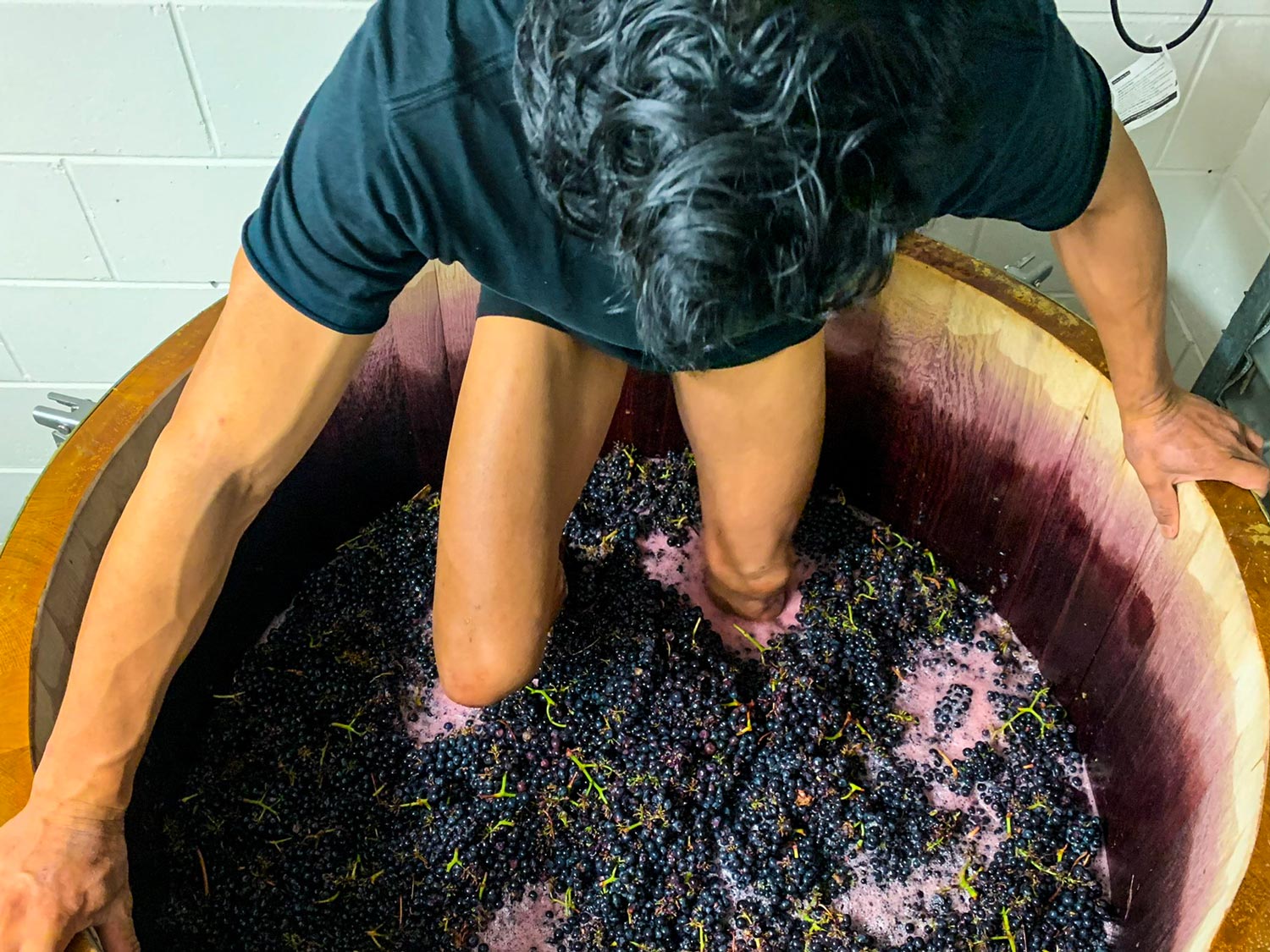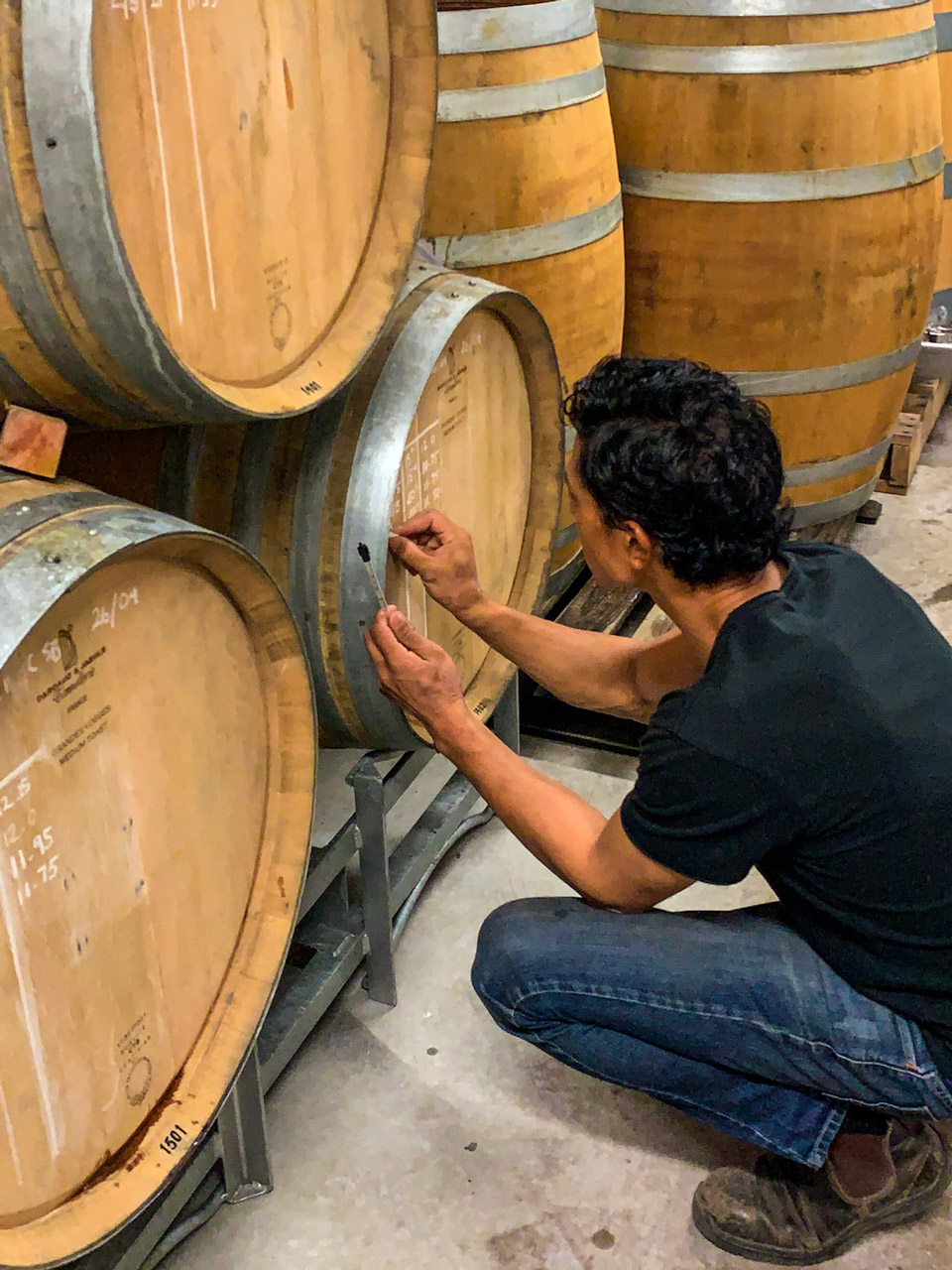Justin Folloso’s career direction snapped into vivid clarity at a Young Gun tasting in 2018. An epiphany with a Tasmanian pinot noir saw him pack his bags and head back to his home state, taking on winery work and travelling overseas to work in Burgundy and California. Today, while working for an iconic Tasmanian winery in his ‘day’ job, Folloso is crafting his own wines at his modest home facility. The launch of the brand comes in 2023, releasing two Coal River Valley pinot noirs from the 2021 vintage and a textural oak-aged sauvignon blanc from 2022.
“The Cave Wines label is the result of a lot of hard work from perhaps a non-conventional journey,” says Folloso. “It’s the intent of my wife and I to create something of our own that we are truly passionate about, in our island home. I am under no illusion that there is so much for me to learn and experience… So, our concept is to make wines in a style that we love to drink, as that is what we do know.”
Diverting from studying a bachelor of agriculture and technology, Folloso set about gaining practical experience in wineries as a cellar-hand. Stints with Nick Farr at Geelong’s By Farr and Frogmore Creek with Alain Rousseau were followed with a vintage at Tyler Winery in California’s Santa Rita Hills. Vintage at Burgundy’s Domaine de Montille came after another harvest at Frogmore Creek, with his current role at Stefano Lubiana Wines starting in January 2020.
“In 2018, I was living in Melbourne,” recounts Folloso. “I went to a Young Gun’s tasting, and I remember I hadn’t had many wines from Tassie for a while. So, when I tasted Gilli and Paul’s [Lipscombe from Sailor Seeks Horse] pinot, it was almost an epiphanous moment where I thought: ‘Woah, I’ve got to get back home.’ …The fruit had this effortless beauty, and it was all in balance. And now, I’m here in Tassie because it’s where pinot should be, and it’s where I have the strongest connection to.”
That connection has been bolstered further with what Folloso describes as a generous wine community.
“The first time I met Dredgy [Peter Dredge] was at the Tasmanian Wine Festival, and he told me something I often think back to: ‘The wine industry always needs good people.’ He then offered my wife and I a ride back to town after having just met us. That sums up the community down here pretty well, I feel. …And then there are my brothers in the industry; the wide-ranging car ride chats with Monksy [Luke Monks] and Marco [Lubiana] whose knowledge and support I lean on a lot. Small town, big heart.”
The inaugural release of Cave Wines in 2023 consists of three wines: two 2021 pinot noirs and a 2022 sauvignon blanc. The fruit for all was sourced from the fabled Nocton Vineyard, but in the 2023 vintage the fruit was farmed by Folloso on a site they recently leased.
“We took over a little vineyard last year between the Coal River and Derwent valleys,” says Folloso. “Pinot noir, cabernet sauvignon and a little chardonnay all planted from cuttings by Robert Carnevale in 1996. Over the years, Robert has had to use two inorganic sprays, and we are looking to take those organic practices further this year. We aim to turn a couple of season’s worth of canes into biochar, introduce mulching, spray some biodynamic preps and potentially try alternating between sulphur and milk sprays for powdery and downy.”
The lack of a tractor means a lot of hard work, but the primacy of vineyard health in making the best wine possible is as important to Folloso as it is at his ‘day’ job working for Steve and Marco Lubiana. “Taking inspiration from our heroes and this beautiful place, Lutruwita, we are looking to make wine with complexity through nuance… Our aim is to create wines with integrity, retaining aromatic integrity and integrity of place, wine that speaks of the beauty and rawness of Tasmania.”
Folloso notes that it probably sounds like a cliché now, but COVID downtime helped get their project off the ground. “We’d just come back from Europe with the feeling that you could do so much with so little,” he says. “Our friend John Purcell was making his delicious Vin Noe label in the Auxey-Collective, a tiny single-storey winery space with a 2 metre by 4 metre cave at the back. I guess that’s when we thought starting small could actually work. There was never going to be a perfect time, and life is too short.”
That idea of being able to start small was as important as the forum to share ideas and lessons learnt. “Growing and making wine is such a human endeavour,” says Folloso. “It’s shaped by the people that grow it and make it who are a product of the people who have shaped them. Just the way I’ve been shown that generosity to help the next wave grow and develop is something I’ve always tried to share with the teams I’ve worked with. This is an industry that is so human, in that you will never stop learning. Learning from experiences, from the ferments, from the land, the seasons and the people. …We may only have 30 more chances to make the best wines we possibly can. It’s the pursuit that’s exciting.”
For Folloso, the variety that sent him back home will always be his focus, regardless its many challenges, or perhaps because of them. “Making wine in general is a grind but pinot in particular – you’ve got to want it. It’s the heartbreak grape. It can be delicate, fickle and an absolute struggle to get right, but when you find a wine that is just pure beauty, ethereal and complex in its nuance – you get it. And because it’s all nuance, I see it as the variety that gives the most transparent portrayal of terroir. …There are a lot of days that take true grit to get through that grind, but that everyday grind has become my passion.”
Although the opportunity to work with fruit from other areas is one that he would grab, Folloso’s two vintages have been focused on the Coal River Valley. “There’s a decent amount of clay to give the wine a raw, savoury element when there’s a lot of rain, but then it hits limestone and sandstone, giving that acid structure to carry the fruit. We want the prettiness of the wine to be at the forefront and then build the nuanced layers behind it. Pinot being so delicate, it can easily get lost behind big tannin and overworked fruit, so we feel by focusing on balance and the aromatics, we will be closer to showing the beautiful place it’s from.”
The sauvignon blanc was made in a way that was intended to build texture and detail. “It was given a foot tread in the picking bins to gain more lees and have a better extraction,” Folloso says. “It was basket pressed and blended in tank, stirring the lees up to ensure even distribution before being sent to barrel. It fermented over 30 days, then was blended and sulphured to retain acidity to carry the tropical fruit characters. It stayed in barrel for a total of 6 months. The wine is un-fined and unfiltered to enhance aromatics, texture and complexity.”
The future will certainly hold more wines, but for the moment, Folloso says they are not hurrying things. “The dream is to grow beautiful and honest wines. We’re starting small and trying to take the small steps towards it. We’re not in any great rush. It’s pretty fun to be learning and taking the experiences as they come. Pinot and chardonnay will always be the passion but there may be the different variety made here and there. What we do know is, it’ll always be Tassie.”






